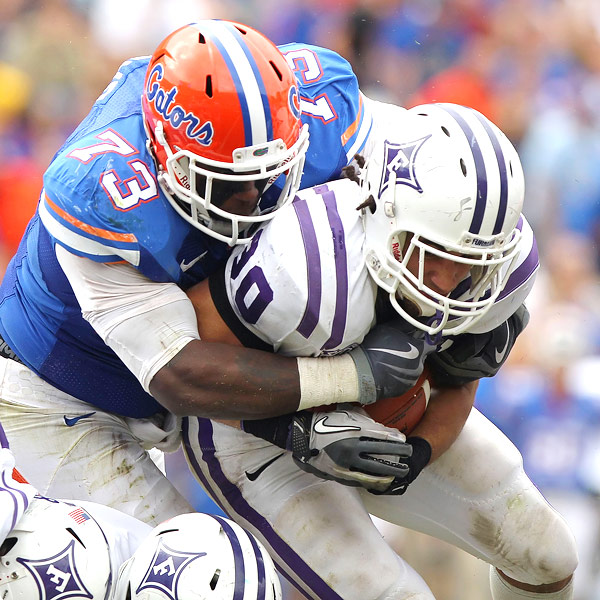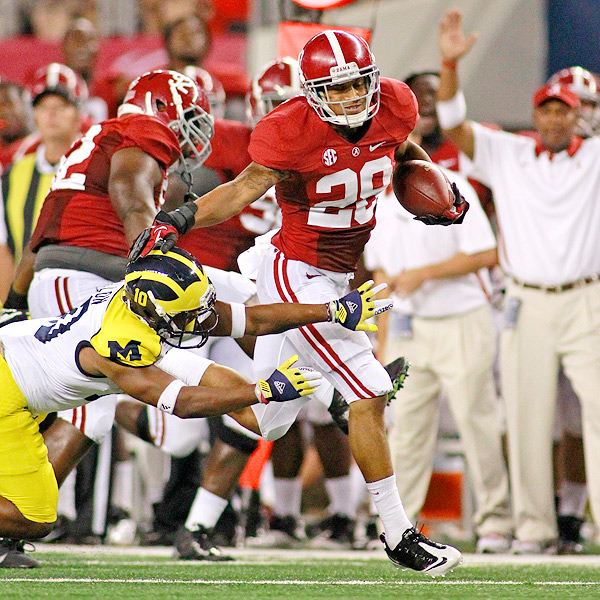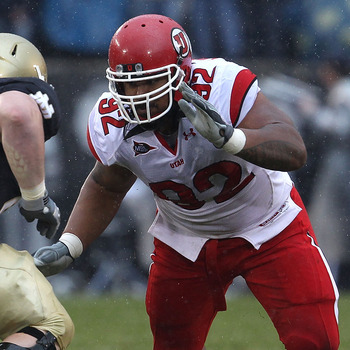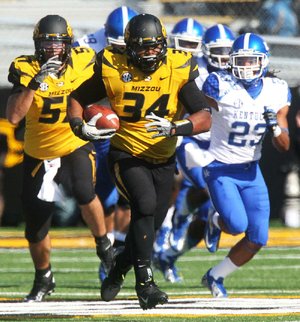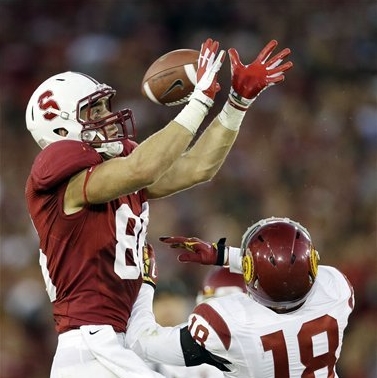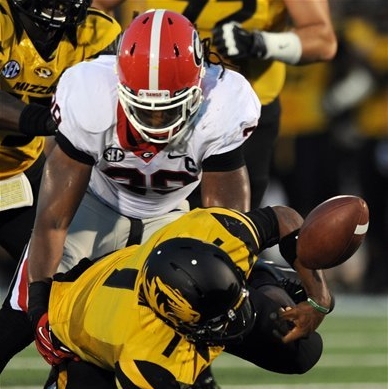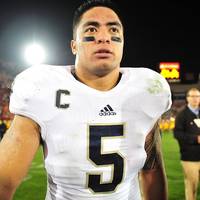
Georgia's John Jenkins is a 358lbs monster
On Tuesday a couple of people touted the idea of drafting a big defensive tackle with the 25th pick. Essentially, not an orthodox three technique.
JW commented: “I understand the speed issue, but if you can’t find a pure 3-tech, getting a wide body with good push who will consistently command a double team, and if your 1-tech and 5-tech also demand respect, that pocket is going to be sloppy and the Leo is going to have some shots. I’m not sure how much Branch commanded a double team. I wonder if there’s a paucity of 3-techs and it’s not solved in the draft, the hawks brass might think hard about going to a wide-9 and double three alignment more often in order to get more isolation shots. Their LBs are quick enough, Kam can handle the run, so it mitigates the run gashes somewhat. Might be worth revisiting the alignments in 3rd and long if they can’t satisfactorily address the personnel.”
For the last three years, the Seahawks have used quite a sizeable defensive line. Red Bryant has worked at the five technique despite weighing 323lbs. In 2010 Brandon Mebane (311lbs) started at the three with Colin Cole (328lbs) at the one. In 2011 they inserted Alan Branch (325lbs) into the three with Mebane moving across to replace Cole. That’s how it stayed for 2012.
We’ve talked a lot on this blog about drafting a pure three technique. By definition the 4-3 under utilises a natural pass rusher at the position, traditionally weighing around 285-305lbs. They line up next to the LEO and double up to create pressure on the weak side. Instead the Seahawks have used size at the three with mixed results so far.
My argument would be that the pass rush hasn’t been good enough during those three years, provoking a need for change. Total reliance has been placed on Chris Clemons for pressure and sacks and you can’t expect one guy to do it alone in base defense. Getting a natural three technique isn’t easy, but it could be crucial for the future success of this scheme.
On the other hand, perhaps Carroll believes the scheme isn’t the issue? Maybe he feels it’s the personnel? Perhaps a bigger body that can be more disruptive will be the order of the day?
If the second part is true, whether it’s likely to succeed or not, it opens up options we haven’t considered previously. A big space-eater like Johnathan Hankins might be in contention. He offered precious little in terms of pass rush for Ohio State and I’m not a big fan of his skill set. But he’s big, stout and has some athletic upside. ESPN’s Todd McShay gave him to Seattle in his updated mock draft today.
What about the massive John Jenkins at Georgia? He’s 6-3 and 358lbs — a monster of a defensive lineman. He moves well for his size even if he tires quickly (to be expected). Could he be used as a heavyweight powerhouse among the interior, capable of being more disruptive than Branch while also improving the teams run defense?
Could Jesse Williams come in to play? Alabama’s Australian import looks best suited to defensive end in a 3-4, but he played nose tackle in 2012. His main strength is run defense and he’s shown very little interior pass rush on tape. He’s also a baller who plays with intensity and attitude and while he does tend to get dinged up in a lot of games, he also had a big outing against LSU in a key ‘Bama victory this year.
None of these three players are pure pass rushers. Funnily enough of the three, the 358lbs Jenkins is probably the most disruptive. But if they did want to keep size inside, these guys would probably be on the radar.
Sylvester Williams and Kawann Short — who are bigger than the natural three techniques but offer more pass rush — could also come back into focus. Particularly Short — an underrated interior rusher. You just wonder about their upside and necessity to hit the ground running. Neither is a spectacular athlete with unique skills. Williams turns 25 this year, Short will be 24.
I still think this is a tough call. Carroll has highlighted the need to improve the pass rush and I’m not sure getting another big guy will solve that. Alan Branch didn’t do a terrible job and certainly the issues with run defense weren’t solely on him. If the objective is to keep the scheme and invest in an alternative to Jason Jones and find other nickel players, why not just re-sign Branch? Is John Jenkins going to be that much better? To the extent the pass rush greatly improves?
The Seahawks simply don’t collapse the pocket enough and more than anything they just need someone who can be in there to move the quarterback out of position, preferably into the waiting arms of the LEO. A big man can do this sometimes with a dynamic bull rush, but more often than not they lack the kind of explosive first step to shoot a gap or knife through. If it’s about combining size with pass rush — draft Kawann Short. He’s the player most likely to get into the backfield and he plays at a comparable weight to Mebane. I’m not sure Jenkins, Hankins or Williams will be enough of a difference maker in terms of improving the pass rush — the key issue highlighted by Carroll at the end of the season.
JW made a good point when he said, “I wonder if there’s a paucity of 3-techs and it’s not solved in the draft.” He’s absolutely right. There aren’t many great three techniques in the league. They’re like gold dust. There’s no exact science to it, but some of the best looking college three techniques just haven’t worked out in the NFL. It’s why I like Penn State’s Jordan Hill. I wouldn’t bank on him being the guy to get Seattle out of this pass rush dilemma, but I’d take a flier in the mid-to-late rounds regardless of what happens with the #25 pick.
The lack of choice and likelihood that Sheldon Richardson and Sharrif Floyd will go in the top-15 keeps pushing me towards free agency. Randy Starks isn’t just an ideal physical match for the three, he’s also an above average run stopper. As far as I’m concerned, that’s the guy this team needs to target. Sign him to a two-year deal and if Richardson, Floyd or whoever isn’t there… keep searching for that next mid-round gem like a Jordan Hill.
Yet I wouldn’t completely rule out a big man being drafted early. As we mentioned, they’ve used three big lineman so far under Carroll. There’s also the San Francisco 49ers factor to consider. The Seahawks need to stay one step ahead of their NFC West rivals. The Niners run the ball so effectively behind possibly the best offensive line in the NFL. Being big, strong and stout up front will be key for the Seahawks in future meeting against San Francisco. The best way to combat the likes of Mike Iupati, Joe Staley and Anthony Davis might be to introduce them to a 358lbs defensive tackle who moves like he weighs 310lbs.
Drafting a big tackle at #25 isn’t something we’ve discussed much so far and I’d be interested to hear what you make of it. I’ve included tape below of the big guys discussed in this piece.


